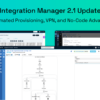For many companies, their ERP – or enterprise resource planning software – is the lifeblood of their organization. These powerful systems help companies manage and streamline multiple critical business processes under one roof. Having a single, centralized system for your finances, human resources, supply chain management, e-commerce solutions, and customer service results in a more complete view of your company’s data.
Or at least, that is the idea behind an ERP. However, as today’s business systems have evolved, the need to be able to integrate your ERP across a diverse, even heterogeneous, IT ecosystem has grown. But ERPs, like JD Edwards, haven’t always played nice with other systems. As a result, any integration project involving an ERP can be up against a number of significant challenges to be successful.
ERPs aren’t built to integrate JD Edwards with 3rd party systems
Built with the intention of providing a one-stop-shop for the most important business processes, 3rd party integrations are an afterthought for many ERPs. While it is possible to build connections to other systems, frequently the integrations must be custom built.
A frequent solution is to create point-to-point integrations between a 3rd party system and an ERP, but this creates its own set of problems. For instance, these connections are brittle and can be very high-touch for IT teams.
The number of outside systems used by modern businesses further exacerbates the problem, as does the increasing adoption of cloud applications. Integrations with important cloud-based systems, like Salesforce or Workday, are becoming more important, with 86% of enterprises having adopted cloud-based services for some portion of the business.
Line-of-Business groups have special needs
As SaaS and PaaS systems have become increasingly ubiquitous, it’s become more common for departments outside of IT to acquire software that better meets their needs than what may be offered within the company, if there even is a solution available.
Sometimes referred to as “Shadow IT”, this software used at the line-of-business can become a headache for central IT when data is needed from systems like an ERP. Without an integration strategy, both IT and the line-of-business can face a lot of chair-turning and double entry to get everything they need. This also increases the number of end-points for integrations.
Real-time integrations should be immediately available
If you are able to create an integration between your ERP and another system – or more likely, many others – batch processing is the most common method of exchanging data between an ERP and other business systems.
There are use cases that make batch processing more cumbersome than helpful. If your organization wants to automate your warehouse, long periods with no messages can mean the difference between rapid order fulfillment and not realizing your warehouse’s full potential.
Special skill set required for customized integrations
Last on this list, but certainly not least, are the skills needed to build the integrations between systems. Customized integrations can require deep knowledge of the ERP to create a useful tie between systems. With typically small teams dedicated to the care and feeding of an enterprise’s ERP, getting time with people who understand how the system works can slow down an integration project.
Worse, if an upgrade to the ERP changes a core system, a custom integration may cease to work. This, again, will require the help of someone with specialized knowledge of the ERP to help troubleshoot and fix the issue, leaving an integration dead in the water until such a resource is available. We call this the spaghetti monster!
This may sound like an insurmountable list of issues when it comes to integrating your ERP with the rest of your business, but it doesn’t have to be that way. If your roadmap includes building integrations to JD Edwards, learn about the PortX JDE Connector, or download ModusBox’s white paper, Best Practices for JD Edwards Integrations, and find out how to overcome the challenges of connecting your most critical business system to the rest of your IT ecosystem.






